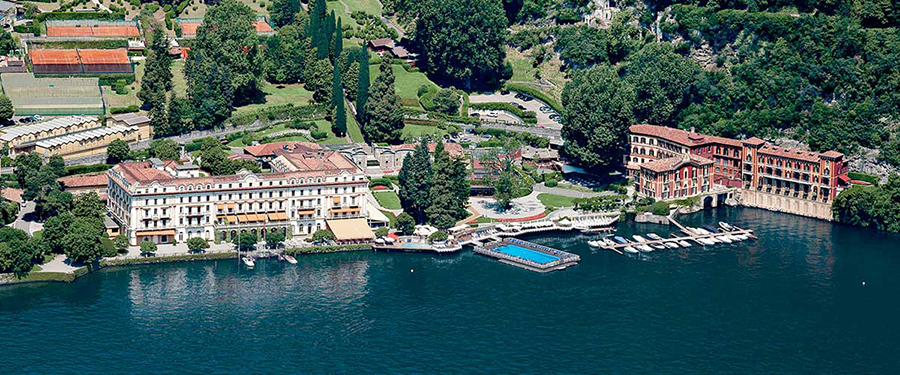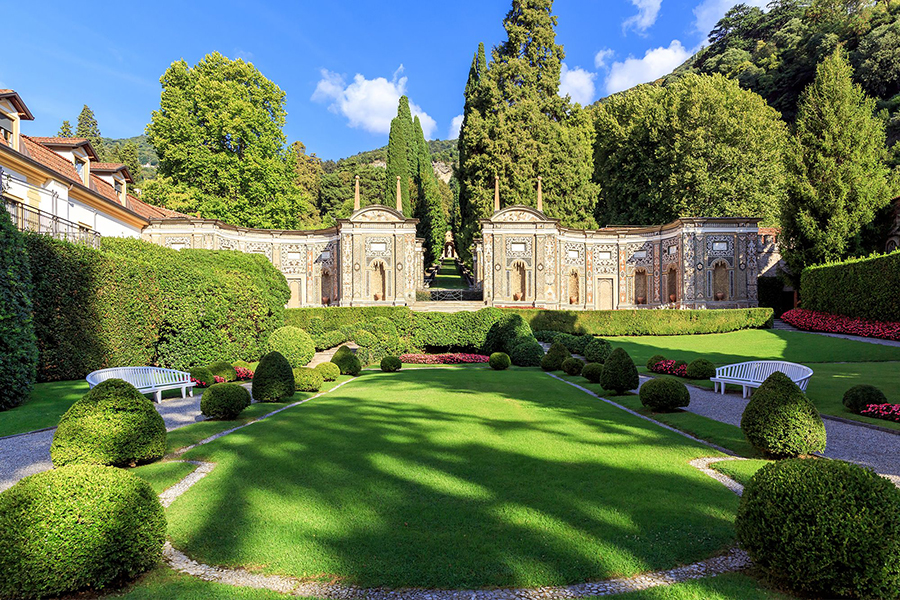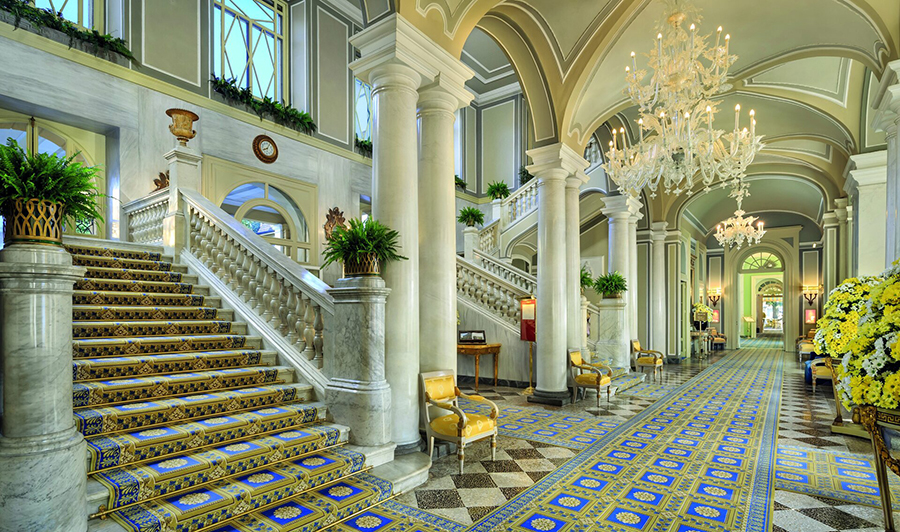Email
Website
www.villadeste.com
The story of Villa D'Este, originally known as villa Garrovo
In the past, on the very spot where nowadays is the Villa d’Este, there was a monastery for nuns that the then Bishop of Como, Gerardo from Landriano, turned into the Cloister of Saint Andrew in 1442.
When convent was suppressed, the building was sold to Cardinal Ptolemy Gallio who had it pulled down in 1568. On the same spot of the monastery he had an impressing residential mansion build on a project by the well known architect Pellegrino Pellegrini.
In 1589, the historian Paolo Giovio in his book Description Lari describes Cardinal Gallio’s mansion calling it Garvinia, by misspelling the mane of the brook, the Gàrrovo, which goes into the lake not far from the nowadays drive entrance of the Hotel Villa d’Este.
At that time, the stream was badly conveyed and its banks were covered with brushwood and because of that it was named Gàrrovo deriving it from the dialect word Garuff that described slovenliness of the place.
At the death of Cardinal Gallio, the Villa Gàrrovo was inherited by his nephew Ptolony, who lived in it with his wife and his son Francesco frequently having artists, writers and royalty as guests. In summer 1615, the Gallios gave hospitality to the heir to the throne of Morocco for a long time.
In 1749, Villa Gàrrovo was temporarily given free of charge to the Jesuit Priests.

In 1769 the villa passed in property to the Earl Odescalchi, and then it was bought by General Ruggeri Marliani, who kept it till 1782.
In 1784 the Villa was inherited by Marquis Bartolomeo Calderara who lived there together with his wife Victoria Peluso, who planned the gardens crossed by the beautiful paths, including the one after the Villa d’Este at Tivoli, which leads to the statue of Hercules, as well as the many restoration works which brought the villa back to its ancient beauty, after decades of slow but steady decline.
During the Napoleon era, it is said that the beautiful Marquise Calderara had not been insensible to the charm of the handsome Colonel of the Grenadiers Domenico Pino, an hero in many Napoleon’s battles. It seems that at the end of a fight between Colonel Pino and the Marquise’s husband, the two men fought a duel and that Marquis Calderara was slashed with a sabre. Anyway, in 1806 the Marquis died and his widow soon after married Domenico Pino who in the meantime had become General, Minister of War and Count of Napoleon’s Empire. Even nowadays, inside Hotel Villa d’Este, there is a room dedicated to Napoleon 1st. which yellow silk tapestry with the crowned “N” had been especially woven for General Pino.
In Autumn 1814, arrived on Lake Lario shores the German Princess Caroline Amalie Elisabeth of Brunswick Wolfenbuttel, wife to Prince George, August Fredrik of Hannover Braunsc Prince of Wales and future King George IV of Great Britain. At first she went to stay at Villa La Rotonda at Borgo Vico in Como, as a Guest of Marquis Villani, but soon after having visited the Villa Gàrrovo, she fell in love with it and she wanted to buy it.
The owner of the villa, Countess Pino, agreed to sell it to her with a deed signed on July, 17th 1815. Through this document we come to know that she paid the Villa 7,500Golden Louis of France. In this deed, Countess Pino wanted to include a statement which pointed out that she was selling her Villa Gàrrovo only to please the Princess.
The scientist Alessandro Volta countersigned the deed on behalf of Princess Caroline Amalie Elisabeth of Brunswick Wolfenbuttel, wife to Prince George, August Fredrik of Hannover Braunsc Prince of Wales. After having sold Villa Gàrrovo, Count and Countess Pino moved to the Villa Nuova at Cernobbio, now within the park of Villa Erba, where General Pino died in March, 26th 1826.
The new name of Villa D'este
The Princess of Wales changed name of Villa Gàrrovo into Villa d’Este, of better, New Villa d’ Este not to mistake it with the one at Tivoli, because the historian and man of letters Abbot Bellini, while studying some antiques documents discovered that the Princess was descended from a certain Guelfo d’Este, who lived about the year 1054.
During following the three years the Princess lived in the villa only for short periods at a times as she was always on the go, travelling all over Italy and Greece; nevertheless she had a real theatre built in which were played both tragedies and comedies.
When the Princess died Villa d’Este passed in property to the roman Princes Torlonia and then to the Orsinis, who, in 1822 sold the villa to the patriot Ippolito Ciani who kept it till he died in 1868. He had a small villa built he called Malakoff for remembering Sebastopol Fort conquered by Mac Mahon in 1855; he also enlarged the park of the villa.
In 1856, he had a house built in Moresque Style (now used as Dependance of the Grand Hotel Villa d’Este), he called Reine d’Angleterre (Queen of England) to the memory of the unfortunate Princess of Wales, a building he Hydropathical Spa, which he opened to people in the same year. The entrance to the Spa was possible either from the road to Moltrasio or from the lake, but not from Villa d’Este that remained unapproachable to the regular customer of the Spa.
In 1868 Villa d’Este was rented to Tsarina Mother Fiedorovna of Russia, widow of Tsar Nikolas 1st: the people of Cernobbio hoped that the presence of the Empress both the Villa and the village could revive the former splendour, unfortunately, the Tsarina never grew fond of Cernobbio that she left before long.

The Villa D'este today
At the death of Baron Ippolito Ciani, Count Giulio Belinzaghi suggested to the Mayor of Milan and to the heirs of the Baron to sell the Villa d’Este to Company that turned it into the Grand Hotel Villa d’Este.
Madame Dombré together with her husband Commentator Tommaso, took care of the transformation of the Villa into a large hotel unit with great taste, elegance and capability; their work was then carried on by their son Mr. Willy. This imprinting of elegance and refinement remained unchanged through the years and every year important people from all over the world come to this very exclusive hotel on the shore of Lace Como.
